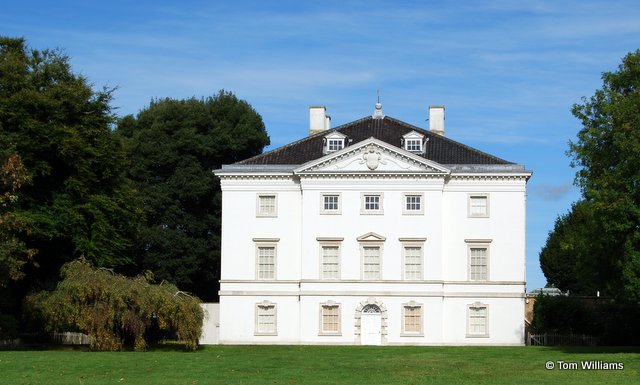I’ve blogged in the past about Henrietta Howard and her home at Marble Hill in Twickenham, where she lived after leaving the court of King George II in 1734. Unkind courtiers at St James’s Palace suggested that she was abandoning the glittering centre of London society for a dull life in the countryside, which Twickenham then was. After she had been only a year at Marble Hill, though, Alexander Pope, the poet, was to write: ‘There is a greater court now at Marble Hill than at Kensington’.

Why did Henrietta choose to settle in Twickenham, and what was it about her life at Marble Hill that made such a centre of intellectual society?
She knew Twickenham because George spent much of the summer at Richmond. It had long royal associations (the Tudor palace there was particularly fine) and Kew Palace, where George III liked to spend time with his family, still stands in Kew Gardens. On the river between the court at Saint James’s in Kensington and Hampton Court Palace to the west, Twickenham, and what was known as the Arcadian Thames, was a fashionable place to live, with many fine houses along the river. Ham House (currently owned by the National Trust) is the best remaining example, but there were many others. Alexander Pope lived on the river, a mile or so to the west. It was not an especially fine house but he had a large garden that was much admired and, of course, his famous grotto.

(Contemporary sketch by William Kent)
Pope was a friend and (at least until she remarried) an admirer of Henrietta Howard and the fact that he lived in Twickenham was a consideration in her choosing the place as her home. And, as is the way of these things, Pope’s fame as a poet (it’s difficult nowadays to appreciate how well-regarded he was) meant that other literary types were attracted to the area and several of these became regular visitors to Marble Hill. Besides Pope, there was John Gay, the playwright, whose Threepenny Opera’s satirical swipes at the government had caused a scandal, Jonathan Swift, another satirist and the author of Gulliver’s Travels and, later, Horace Walpole, whose eccentric house at nearby Strawberry Hill was to start the English Gothic revival.

A close friend from Henrietta’s days at court, Kitty Hyde, the Duchess of Queensbury, lived just across the river at Hall Place in Petersham. (Horace Walpole, who found her irritating, remarked that at least they had the river between them.) The Duchess was an interesting woman, a great beauty and known as an eccentric even in an age of eccentrics. She was banished from court in 1728, over her championing of John Gay’s satirical works and responded: “The Duchess of Queensberry is surprised and well pleased that the King hath given her so agreeable a command as to stay from Court.”

All these people were part of Henrietta’s circle, but there were many more famous names living in Twickenham or nearby. Joshua Reynolds, the artist, (two of whose portraits now hang in Marble Hill House) lived on Richmond Hill with a view that stretched out across the Arcadian Thames towards Twickenham. Hogarth was nearby in Chiswick. (There’s a painting of his displayed at Marble Hill as well.) Horace Walpole (in 1755) produced a convenient list: “We shall be a celebrated as Baiae or Tivoli … we have very famous people: Clive and Pritchard, the actresses: Scott and Hudson, the painters: my lady Suffolk [Henrietta Howard]: Mr Hickey the impudent lawyer: Whitehead the poet: and Cambridge, the everything.”
Richard Cambridge (1717-1802) moved to Twickenham in 1751, taking a house just a few minutes walk along the river from Marble Hill. Cambridge is not remembered these days but was a well-regarded poet at the time and a man who seemed to know everybody. While Henrietta Howard entertained literary figures, Cambridge’s visitors included Lord North (Prime Minister to George III), Captain Cook (who called before his last voyage), Edward Gibbon (who wrote The Decline and Fall of the Roman Empire) and James Boswell and Samuel Johnson, who, it seems, were inseparable even in their dinner invitations.

By the time Henrietta died in 1767, many of those who had been part of her circle at Marble Hill were dead. Walpole, much younger than her, was still very much alive. (His novel, The Castle of Otranto, arguably the first Gothic novel, was only published in 1764.) He visited her the day before her death, but Pope, Gay, and Swift were all gone.
Twickenham is now part of the London Borough of Richmond-upon-Thames. The London centre of literary society and backbiting gossip has arguably moved to Islington. The authors and poets are less notable now, but Richmond is still home to actresses like Helen Baxendale, Amanda Holden, and Jane Horrocks. In the late twentieth century, it attracted a lot of musical stars (possibly because of the famous concert venue on Twickenham’s Eel Pie Island). Mick Jagger, Pete Townshend and Ronnie Wood all lived here. And, best of all, Richmond is still home to Sir David Attenborough.
If Henrietta Howard were to return to Marble Hill, she would not lack for company.

